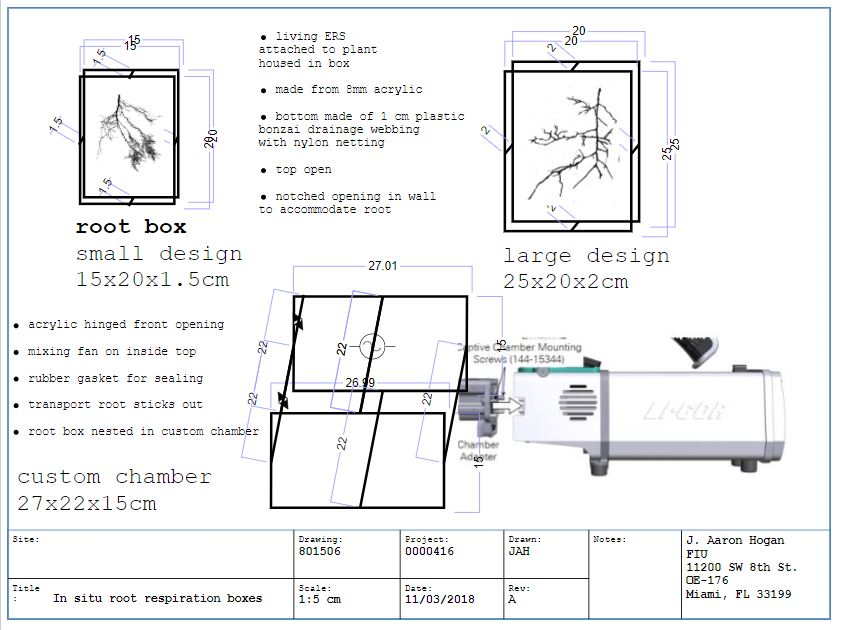|
Generally, the holidays are a time for rest and relaxation. Christmas dinner, college football bowl games, perhaps a little alpine skiing are some of my favorite things to do during winter holiday breaks, which I usually spend in my home state of Colorado. This year I decided to undertake a project that aims to develop a new way to measure root respiration. The idea uses foundational gas exchange theory and the amazing Li-Cor photosynthesis technology (Li-6800). Although the Li-6800 was designed to measure leaf-level photosynthetic CO2 flux, the same basic principles apply when measuring respiration - the metabolic process that consumes oxygen and releases carbon-dioxide as organisms turn food into energy. In fact, when doing a CO2 response curve on a leaf, the instrument measures photorespiration, when the [CO2] is at zero. Root respiration has been hypothesized as a potential key axis in the hypotheical root economical spectrum. Maximum rate of photosynthesis is a main axis in the leaf economical spectrum. Plants with an acquisitive root strategy (high SRL, high root N, thin diameter, and low stele to cortical ratio), should (by definition) have higher rates of metabolic activity (i.e. respiration) than plants with more conservative roots. Currently, most of the data on root respiration rates are either: 1) derived from measuring soil respiration rates which use of collars that include or exclude roots (typically fine and/or coarse roots) (e.g. using a Li-Cor Li-8100 or similar), or 2) measure respiration rates on excised roots in a closed respiration chamber. The first method makes it hard to relate respiration rates to root morphology (SRL, root N content etc.), and in the second method, it is unknown whether respiration rates are affected by root excision, and if rates of root respiration vary temporally or with environment. Thus, I wanted to design a way to repeatedly measure rates of fine root respiration on living entire root systems (ERSs - those containing at least 3 root orders of the most distal fine roots), in a similar way to which we can measure ambient rates of photosynthesis over time on a single leaf. The first step was to design a root box, which houses the living ERS. The design (Figure A) would have to encapsulate the root and surrounding soil in a unit that is easily accessed at the top of the soil A horizon (first 10 cm in soil profile; i.e. just under the organic layer, depending on the the depth of lateral surface roots of the tree you want to measure). The second step is to design a custom respiration chamber that attaches to the Li-Cor 6800 that is capable of measuring the respiration of the root box. It is a nested design, where the root box is gently lifted from the soil where it rests, and inserted into the respiration chamber for measurement, then returned. Root box controls will have to be used to measure rates of soil respiration (microbial and fungal). Root system respiration can then be estimated by calculating the difference. Figure A: conceptual figure for root box and custom respiration chamber design (for Li-6800). With the idea conceptualized, I set out to envision construction and buy materials. I settled on making the root boxes out of plastic buckets that could be sliced into about 1" square strips. I used aluminum meshing for the bottom. This should allow water and nutrient flow and fungal/ microbial activity to occur inhibited in the soil. I went with a heavy duty 1/2" acrylic sheeting for the chamber. I bought some clamp latches and a mixing fan, and some acrylic bonding solvent. All items were found pretty easily on Amazon. So, I went into the holiday break with the idea, the materials were purchased and ready, but needed to do the construction during the break, because several large tools were needed (i.e. a table saw and a drill press). My father (architect and handyman) has a workshop with these tools, and helped me with the construction. Thanks Dad! Overall, I think the construction came out well (pictures below). Whether or not the design will give good data is another thing, entirely. Let's see! Comments welcome, thanks for reading, & happy new year! ♠ Lastly, here are some resources if you are considering constructing a custom chamber for a Li-6800, yourself:
2 Comments
|
AuthorJames "Aaron" Hogan is an ecologist interested in plant biodiversity, forests and global change. Archives
November 2021
Categories |




